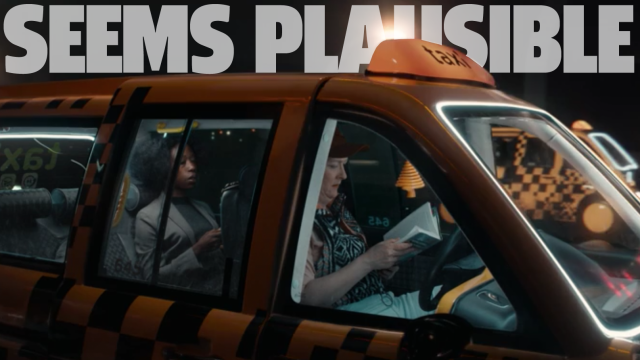HBO’s new comedy series, Avenue 5, is about a luxury spaceliner that goes off-course, and the many and terrible people trapped inside it. There’s a lot of interesting, if deeply cynical, predictions about society and technology to come (triple-marriages will be accepted by the mainstream, artificial gravity is possible, and Daniel Radcliffe shat himself very publicly at a future Super Bowl) but I think the most interesting one has to do with the autonomous taxis shown in the show, which are interesting for one key thing they have inside them: a person.
Not just any person, a very bored person who appears to be paid to be in the vehicle. It seems to be a person who has a job that’s sort of a cabbie, but not necessarily responsible for actually driving. The job seems to be more of a minder of the AV, content to let the car drive itself but ready—or at least ready-ish—to take over if the car’s electronic brains get confused.
We see the AV taxis in a scene where a character is going to the White House, which, for some reason, has been relocated to Buffalo. We get some shots of cars on the road, at night, and behind the futuristic-looking glowing windshield surrounds and other novel accent lighting, the cars themselves appear to be clever little electric vans from the French company called Mia Electric.
These little EVs have a distinctive design with a central driver’s seat and a good amount of interior room. I recognised them right away because we used the Lane Museum’s Mia as a camera car in several episodes of Jason Drives:
I think this portrayal of AVs is the most likely to be accurate because of that minder-person. While it’s clear autonomy has come a long way in the show, the presence of a person paid to be in the car is an interesting realistic touch, an admission that things are not yet perfect, and there’s a number of reasons why you still may want a human involved.
The taxi-attendant, complete with traditional taxi-driver beaded seat cover, is very much not driving. In fact, she’s reading a book. But, she’s still there, and if you owned a near-future AV taxi company, there’s probably a lot of reasons why you want a human there: an emergency backup driver if the car becomes confused, or experiences a technical failure of some kind, to help make sure the cab doesn’t get needlessly vandalised, to perform routine cleaning and maintenance on the vehicle, and, what I suspect is the most likely reason, laws still require a human involved, and insurance companies likely want a person with some accountability in that seat.
There’s also the point that this woman is still employed; keeping some sort of jobs available even with widespread adoption of AVs is very likely to be something many people would want. It’s easy to imagine autonomous big-rig trucks still requiring a “trucker” inside them, even if it’s more of a security guard job than a traditional trucking job.
This is an autonomous future with a hedge, a compromise, and, based on the way most futures end up becoming presents, that’s not an unlikely call at all.
